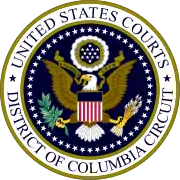Durham v. United States (1954)
Durham v. United States, 214 F.2d 862 (D.C. Cir. 1954),[1] is a criminal case articulating what became known as the Durham rule for juries to find a defendant is not guilty by reason of insanity: "an accused is not criminally responsible if his unlawful act was the product of mental disease or mental defect."[2][3]:
| Durham v. United States | |
|---|---|
 | |
| Court | United States Court of Appeals for the District of Columbia Circuit |
| Full case name | Monte Durham v. United States |
| Argued | March 19, 1954 |
| Decided | July 1, 1954 |
| Citation(s) | 214 F.2d 862; 94 U.S. App. D.C. 228; 45 A.L.R. 2d 1430 |
| Case history | |
| Subsequent action(s) | Petition for rehearing en banc denied, September 10, 1954 |
| Court membership | |
| Judge(s) sitting | Henry White Edgerton, David L. Bazelon, George Thomas Washington |
| Case opinions | |
| Majority | Bazelon, joined by a unanimous court |
| Keywords | |
It was to enable psychiatrists to "inform the jury of the character of [the defendant's mental disease" so that a jury could be "guided by wider horizons of knowledge concerning mental life"[4] so that juries could make determinations based on expert testimony about the disease.[5] It was patterned on State v. Pike.[6][5] It was adopted by only two states, for a short time but is still influential on debate over legal insanity.[5] The decision was criticized for leaving a jury with no standard to judge impairment of reason or control, for not defining mental disease, and for leaving the jury dependent on expert testimony.[5]
References
- Durham v. United States, 214 F.2d 862 (D.C. Cir. 1954).
- Durham, 214 F.2d at 874-75.
- Criminal Law - Cases and Materials, 7th ed. 2012, Wolters Kluwer Law & Business; John Kaplan, Robert Weisberg, Guyora Binder, ISBN 978-1-4548-0698-1,
- Durham, 214 F.2d at 876.
- Insanity, Encyclopedia of Crime and Justice, 1983; Abraham Goldstein; pp736-40
- State v. Pike, 49 N.H. 399 (1869).
External links
- Text of Durham v. United States, 214 F.2d 862 (D.C. Cir. 1954) is available from: CourtListener Google Scholar Justia